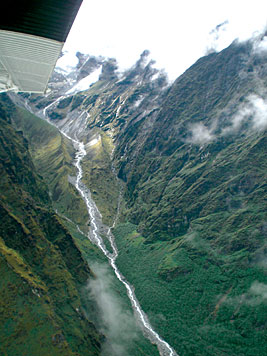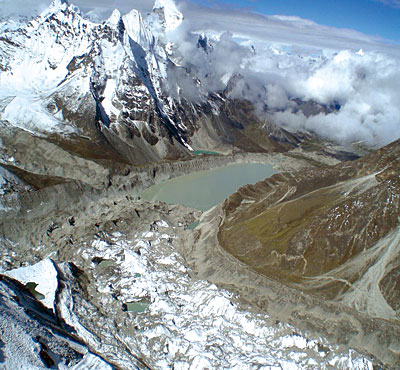The people in the mountains of Nepal do not know that the futures of their children and grandchildren are tied up with how the preparatory meetings for the international climate change conference next week in Copenhagen go.
Will the rich countries agree to cut back to 40 per cent of 1990 emissions in the next ten years (which scientists warn is needed to keep the average rise of global temperatures to within two degrees Celsius) or will they stall at the 13 per cent the Americans say is as far as they can go? The Copenhagen meet will also reveal whether the rich countries are actually willing to help developing countries make the switch from fossil fuel to renewables, and whether they will help to fund adaptation measures so the world's poor can cope with rising sea levels and receding snowlines.
Maps of the Everest region from the 1960s show no water in the Imja Glacier below Lhotse. Today there is a lake here two km long, 500 metres across and 100 metres deep. If Imja Tso bursts, it will unleash a catastrophic flood downstream.
Melting glaciers and receding snowlines are the most dramatic visible proof of global warming. Nearly 1 billion people downstream in China, southeast Asia, India and Pakistan depend on the Himalaya and the Tibetan plateau for water.
But the focus on snow and ice takes attention away from the water. The Himalaya is also a gigantic sponge storing groundwater. In fact, scientists estimate that only nine per cent of the water in the Ganga is from melting glaciers. The rest is from monsoon runoff, and climate change is also affecting weather patterns, leading to extreme rainfall events and droughts.
 ALL PICS: KUNDA DIXIT The Thamserku Glacier with its tongue-shaped moraine indicating the extent of the ice till recently. |
 Green lakes created by the melting glacier, coloured by copper-rich rocks below Ama Dablam. |
 The North Ama Dablam Glacier with melt pools where there used to be ice. |
 MELTDOWN: Imja Tso below the south wall of Lhotse, with Ama Dablam beyond, is now 2 km long. There was no lake here 40 years ago. |
What should Nepal do?
Given the low per capita carbon footprint of Nepalis (less than one ton of carbon dioxide per person per year, compared to 30 tons in Europe and 300 tons per capita in Qatar) the issue of climate equity is bound to come up in Copenhagen next week.
No matter what Nepal does, it will not make that much of a dent in saving the world from climate change. But Nepal needs to switch to renewables not just to do our bit to save the planet, but also to save our economy. Nepal imports all of its petroleum products from refineries in India and the trade deficit is growing. This growing economic reliance on India is going to deepen as the world's oil reserves peak, and crude oil becomes more expensive. This will only increase our political dependence on our southern neighbour. Unless we implement a strategy to start a hydro economy. For Nepal, switching to renewables is a political imperative, not just an environmental question.
READ ALSO:
Climate ironies, EAST WEST with Kunda Dixit, 04 Dec 2009
Dateline Everest - FROM ISSUE #479 (04 DEC 2009 - 10 DEC 2009)
Himalayan tsunami - FROM ISSUE #479 (04 DEC 2009 - 10 DEC 2009)


